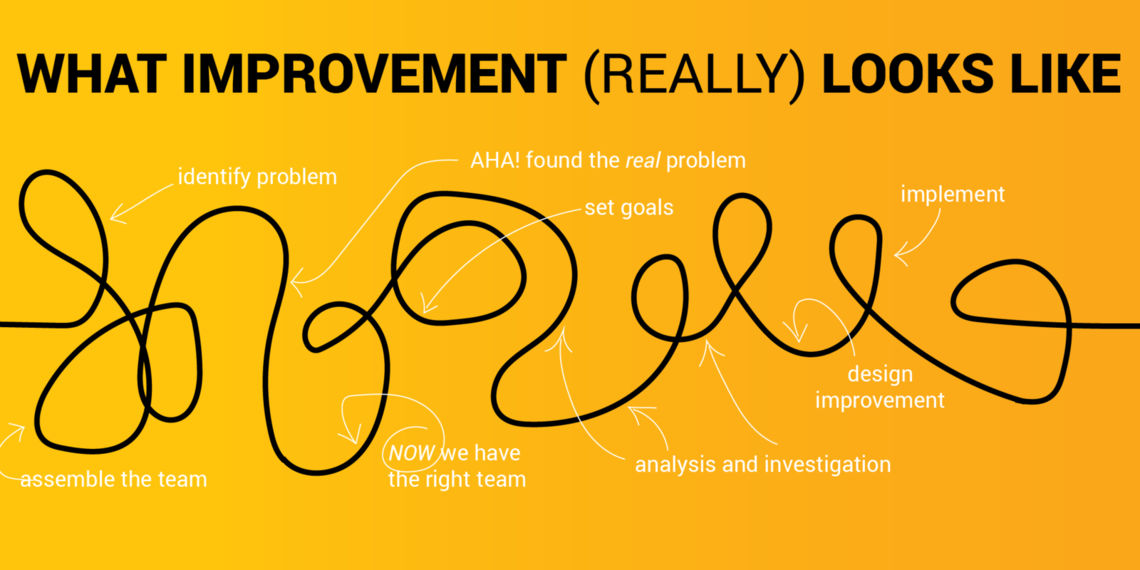The Problem(s)
The Value Summary solves two thorny problems of system-wide improvement:
1. Improvement work isn't easy
Think about the all-too-common issues that plague project teams and health care in general: no clear goals, not understanding the root causes, etc. They’re real. In fact they’re so common, they’re not thought of as problems. It’s not enough to promise yourself to avoid these traps.
2. Engaging an organization isn't easy
Once our large, matrixed academic health center became attentive, sharing and spreading improvement proved challenging. Attendance and an ever-shrinking pool of available time limited the impact of a traditional power-point report out.
Could technology help? We needed a tool to enable the adoption of a standardized improvement method, provide real-time education and coaching, create a forum to share and spread improvement across a system AND give the leader easy, real-time view into hundreds of improvement efforts.
What is it?
The Value Summary is an online portal that helps you act your way into thinking the right way about value improvement.
What does it do?
The Value Summary meets many organizational needs.
1. Guide improvers through standardized methodology
Organizations that know how to improve performance faster adopt a standard methodology. The most well-known of these is Toyota's A3. Using a standard methodology requires discipline, and we’re trying to achieve that discipline through the Value Summary.
U of U Health’s improvement methodology combines lean, Six Sigma, and PDSA approaches. We think we’ve improved upon the A3 with the Value Summary, a modified A3, which guides improvers to ask the right questions to solve the right problems. It is a tool to plan, guide and teach improvement using proven methods.
| Project Phase | Definition | Problems Prevented |
|---|---|---|
| 1. Project Definition | Define the project vision, scope, goals, and team |
|
| 2. Baseline Analysis | Define the current state qualitatively and quantitatively |
|
| 3. Investigation | Use data to direct the project |
|
| 4. Improvement Design & Implementation | Select interventions, test them, and develop a plan to implement |
|
| 5. Monitoring | Track adherence to and performance of your new process |
|
2. Share and spread ideas
Individuals and teams face similar challenges throughout the organization, but the spread of best practices often stops at a group or service line. The organization is large enough and busy enough that people in diverse parts of the organization do not have the opportunity to share. When there have been opportunities to share ideas, people are hungry for it. They love to teach and to learn from each other. They build relationships with each other that end up producing solutions that meet patient needs.
Ideas are more easily spread because of the Value Summary’s centralized online portal. Once a paper form shared through email or shared drives, the Value Summary functioned as an individual planning and reporting tool. Today, the Value Summary portal allows users to search and track efforts in real time. Everyone across our system can now access what they want when they want it.
3. Align the organization
Leaders want to know about the work that is happening on the front lines of health care, and the front lines of health care want their leader's support of their work. But in a complex organization, this flow of information can be stymied. It is important that everyone (leaders, physicians, and employees) in the system can work in and see the same form.
The Value Summary portal provides senior-leader level reporting of aggregate financial impact, team engagement as well as the breadth of projects. Leader-level reports create visibility into front line improvements without the need for formal reporting meetings, which allows executives to support projects in real-time.
Because of the diverse institutional needs reflected in the design, the Value Summary also meets organizational requirements, such as CLER expectations (Resident QI participation), and hospital accreditation (DNV, audit tracking).
4. Incentivize physician engagement
U of U Health utilizes an additional lever to incentivize physician engagement. By using the Value Summary to document improvement work, physicians earn Maintenance of Certification (MOC) Part IV credit. The University of Utah MOC Part IV program utilizes the Value Summary to guide improvement effort through enrollment, tracking, and reporting. To facilitate publication of improvements, the Value Summary is structured to accommodate SQUIRE 2.0 guidelines (SQUIRE is a framework for reporting health care improvements).
University of Utah Health MOC Part IV Improvement Program 2-Year Results

The Reflection
Can one tool enable a learner to act their way into thinking? Throughout the organization, the Value Summary is the only way to plan, measure and communicate the successes (and failures) of value work.
But our organization is more than just the sum of hundreds of Value Summaries. While the Value Summary was created for institutional reasons, it has impact for individuals. The Value Summary has become a path for self-reflection and learning. The Value Summary creates a scholar in every improver by reflecting on the steps taken and what made the effort successful.
Chrissy Daniels
Mari Ransco
Brittany Patterson
Urogynecology specialist Whitney Hendrickson-Cahill details the steps an interdisciplinary team followed to reduce surgical site infections (SSIs) following hysterectomy procedures, aiming to improve patient outcomes, shorten recovery times, and reduce healthcare costs at University of Utah Health.
Former Chief Quality Officer Sandi Gulbransen and Accreditation Manager Kemper Funk explain how this umbrella of standards—ISO-9001—relates to our accreditation process and impacts our daily work.
In an organization as big as U of U Health, it’s hard to know where our work fits into the big picture. System Planning Manager Cassandra Taft highlights five ways teams can meaningfully contribute to Operational Plan priorities, regardless of job role or responsibility.
